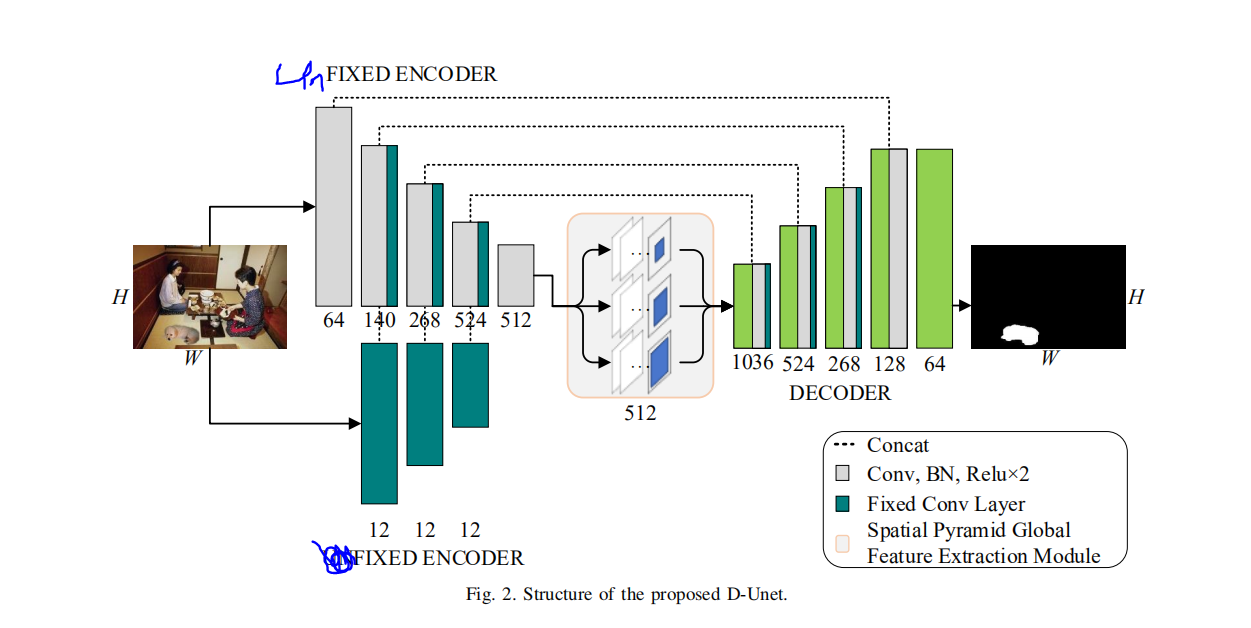论文名:D-Unet: A Dual-encoder U-Net for Image SplicingForgery Detection and Localization
arxiv 2020
复现时间 2021/4/24 使用pytorch
这个论文的创新性不高,希望诸君绕过。论文甚至是把图片给写错了。实在是过分。

关于人工特征融入深度网络的思考。
使用某种图像库可以很轻易 的得到人工特征。
但是这个东西是用CPU计算的,而pytorch是拿GPU跑的。
在实现上不是很难,就是注意CPU和Conda。
但是把这玩意从CPU,GPU里面复制来,复制去 的。个人认为电脑会’累‘的,电脑肯定会累的,会跑的很慢。
下面是用这种很笨的方法实现的3重Harr小波。没有效率的方法。
复制代码
1
2
3
4
5
6
7
8
9
10
11
12
13
14
15
16
17
18
19
20
21
22
23
24
25
26
27
28
29
30
31
32
33
34
35
36
37
38
39
40
41
42
43
44
45
46
47
48
49
50
51
52
53
54
55
56
57
58
59
60
61
62
63
64
65
66
67
68
69
70
71
72
73
74
75
76
77
78
79
80
81
82
83
84
85
86
87
88
89
90
91
92
93
94
95
96
97
98
99
100
101
102#xioabo.py #!/usr/bin/env python # -*- coding:utf-8 -*- import numpy as np import pywt import cv2 import matplotlib.pyplot as plt import torch def xiaob(img): img=img.reshape(img.shape[1], img.shape[2],img.shape[3]) img = img.permute(1, 2, 0) img=img.cpu().numpy() # 把数据集中的tensor转numpy # print(type(img2)) # img3 = cv2.resize(img2, (448, 448)) b, g, r = cv2.split(img) x = (b, g, r) count = 1 for img in x: # plt.figure('二维小波一级变换') coeffs = pywt.dwt2(img, 'haar') cA, (cH, cV, cD) = coeffs # 将各个子图进行拼接,最后得到一张图 '''AH = np.concatenate([cA, cH], axis=1) VD = np.concatenate([cV, cD], axis=1) img = np.concatenate([AH, VD], axis=0)''' # 显示为灰度图 ''' plt.imshow(img, 'gray') plt.title('result') plt.show()''' cA = torch.from_numpy(cA) cH = torch.from_numpy(cH) cV = torch.from_numpy(cV) cD = torch.from_numpy(cD) cA = cA.resize(1, cA.shape[0], cA.shape[1]) cH = cH.resize(1, cH.shape[0], cH.shape[1]) cV = cV.resize(1, cV.shape[0], cV.shape[1]) cD = cD.resize(1, cD.shape[0], cD.shape[1]) if count == 1: # y1 = (cV, cA, cH, cD) # cv2.imshow("y1", cD) outputs1 = torch.cat((cV, cA, cH, cD), dim=0) k=cA # print(outputs1.shape) if count == 2: # y2 = (cV, cA, cH, cD) outputs2 = torch.cat((cV, cA, cH, cD), dim=0) k = torch.cat((k, cA), dim=0) if count == 3: # y3 = (cV, cA, cH, cD) outputs3 = torch.cat((cV, cA, cH, cD), dim=0) k = torch.cat((k, cA), dim=0) count += 1 out = (outputs1, outputs2, outputs3) outputs = torch.cat(out, dim=0) outputs=outputs.resize(1,outputs.shape[0], outputs.shape[1], outputs.shape[2]) k=k.resize(1,k.shape[0], k.shape[1], k.shape[2]) return (k.cuda(),outputs.cuda()) # 12层特征 # 将多通道图像变为单通道图像 # img = cv2.cvtColor(img, cv2.COLOR_BGR2GRAY).astype(np.float32) # img = cv2.imread("C:/Users/brighten/Desktop/1.jpg") #img = torch.rand(size=(3,224, 224)) #img=img.permute(1, 2, 0) # print(img.shape) # print(img) '''k,y = xiaob(img) print(k.shape) print(y.shape) k,y = xiaob(k) print(k.shape) print(y.shape)''' # cv2.waitKey(0) ''' (180, 130, 3) torch.Size([4, 90, 65]) torch.Size([12, 90, 65]) 输入rgb 图像,(w,h,3) 输出 tensor张量 (12,w/2,h/2) 这两个表示图层的方式不一样 改后。 输入张量 意思是把输入的张量按照numpy 的方式放置维度信息 输出张量 大小同上 '''
最后
以上就是还单身康乃馨最近收集整理的关于D-net论文复现部分内容 --关于人工特征融入深度网络的思考。的全部内容,更多相关D-net论文复现部分内容内容请搜索靠谱客的其他文章。
本图文内容来源于网友提供,作为学习参考使用,或来自网络收集整理,版权属于原作者所有。








发表评论 取消回复